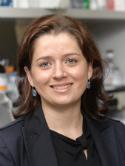The repertoire of somatic genetic alterations of acinic cell carcinomas of the breast: An exploratory, hypothesis-generating study Journal Article
| Authors: | Guerini Rocco, E.; Hodi, Z.; Piscuoglio, S.; Ng, C. K. Y.; Rakha, E. A.; Schultheis, A. M.; Marchiò, C.; Da Cruz Paula, A.; De Filippo, M. R.; Martelotto, L. G.; De Mattos-Arruda, L.; Edelweiss, M.; Jungbluth, A. A.; Fusco, N.; Norton, L.; Weigelt, B.; Ellis, I. O.; Reis-Filho, J. S. |
| Article Title: | The repertoire of somatic genetic alterations of acinic cell carcinomas of the breast: An exploratory, hypothesis-generating study |
| Abstract: | Acinic cell carcinoma (ACC) of the breast is a rare form of triple-negative (that is, oestrogen receptor-negative, progesterone receptor-negative, HER2-negative) salivary gland-type tumour displaying serous acinar differentiation. Despite its triple-negative phenotype, breast ACCs are reported to have an indolent clinical behaviour. Here, we sought to define whether ACCs have a mutational repertoire distinct from that of other triple-negative breast cancers (TNBCs). DNA was extracted from microdissected formalin-fixed, paraffin-embedded sections of tumour and normal tissue from two pure and six mixed breast ACCs. Each tumour component of the mixed cases was microdissected separately. Tumour and normal samples were subjected to targeted capture massively parallel sequencing targeting all exons of 254 genes, including genes most frequently mutated in breast cancer and related to DNA repair. Selected somatic mutations were validated by targeted amplicon resequencing and Sanger sequencing. Akin to other forms of TNBC, the most frequently mutated gene found in breast ACCs was TP53 (one pure and six mixed cases). Additional somatic mutations affecting breast cancer-related genes found in ACCs included PIK3CA, MTOR, CTNNB1, BRCA1, ERBB4, ERBB3, INPP4B, and FGFR2. Copy number alteration analysis revealed complex patterns of gains and losses similar to those of common forms of TNBCs. Of the mixed cases analysed, identical somatic mutations were found in the acinic and the high-grade non-acinic components in two out of four cases analysed, providing evidence of their clonal relatedness. In conclusion, breast ACCs display the hallmark somatic genetic alterations found in high-grade forms of TNBC, including complex patterns of gene copy number alterations and recurrent TP53 mutations. Furthermore, we provide circumstantial genetic evidence to suggest that ACCs may constitute the substrate for the development of more aggressive forms of triple-negative disease. © 2015 Pathological Society of Great Britain and Ireland. Published by John Wiley & Sons, Ltd. |
| Keywords: | immunohistochemistry; adult; clinical article; human tissue; aged; middle aged; unclassified drug; gene mutation; somatic mutation; exon; frameshift mutation; follow up; dna repair; breast cancer; gene expression; protein; brca1 protein; phosphatidylinositol 3 kinase; protein p53; uvomorulin; breast carcinoma; mammalian target of rapamycin; cancer size; gene dosage; epidermal growth factor receptor 3; acinar cell carcinoma; beta catenin; genomic dna; fibroblast growth factor receptor 2; epidermal growth factor receptor 4; copy number variation; triple negative breast cancer; tp53; massively parallel sequencing; indel mutation; triple-negative; human; priority journal; article; inositol polyphosphate 4 phosphatase type 2 |
| Journal Title: | Journal of Pathology |
| Volume: | 237 |
| Issue: | 2 |
| ISSN: | 0022-3417 |
| Publisher: | Wiley Blackwell |
| Date Published: | 2015-10-01 |
| Start Page: | 166 |
| End Page: | 178 |
| Language: | English |
| DOI: | 10.1002/path.4566 |
| PROVIDER: | scopus |
| PUBMED: | 26011570 |
| PMCID: | PMC5011405 |
| DOI/URL: | |
| Notes: | Export Date: 2 October 2015 -- Source: Scopus |
Altmetric
Citation Impact
BMJ Impact Analytics
MSK Authors
-
 762
762Norton -
 105
105Edelweiss -
 459
459Jungbluth -
 646
646Weigelt -
 642
642Reis-Filho -
 155
155Ng -
 130
130Piscuoglio -
 69
69Martelotto -
 30
30Fusco -
 148
148Da Cruz Paula -
 27
27Marchio -
 38
38Schultheis -
 28
28De Filippo
Related MSK Work





